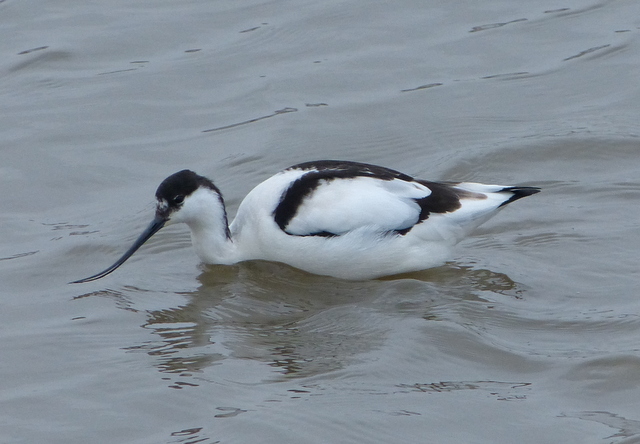A Private Tour today in North Norfolk. The brief was to see a good variety of birds, with a particular wish to see a Spoonbill.
We started at Titchwell. An early walk round the car park produced a pair of Bullfinch feeding on the buds in the Blackthorn, which is now coming into flower. Their delicate piping gave them away, and we got great views of both the stunning pink male and subtler grey-brown female through the scope. On the walk to the visitor centre, a Goldcrest was singing. It landed in a small tree by the path, only a couple of feet away from us, seemingly oblivious to our presence and focused only on finding food.
We had not even got onto the main footpath when we spotted a Water Rail scuttling along the bottom of the ditch in front of us. It disappeared straight into some dense vegetation but after waiting quietly for a minute, it walked back out into the open. We got a great look at it, feeding quietly. We had just set off again to walk out onto the reserve when a second Water Rail ran along the ditch on the other side.
Several Cetti’s Warblers sang from the bushes in the reedbed, but didn’t come out. A Chiffchaff called from the reeds as well. A pair of Marsh Harriers circled over, but the breeding activity of recent days seemed to have stalled. It was perhaps a little too cloudy and cold in the brisk north wind today.
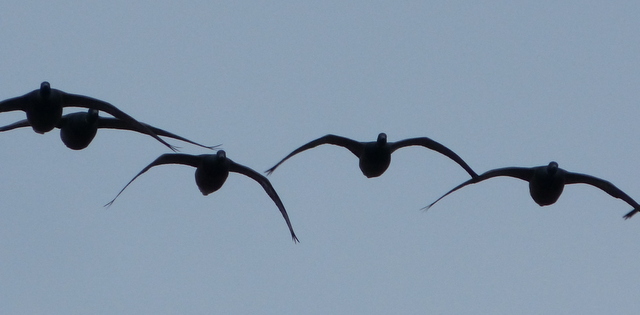 Brent Geese – flying in to the freshmarsh to bathe
Brent Geese – flying in to the freshmarsh to bathe
As we walked out towards Parrinder Hide, a large flock of Brent Geese took off from the saltmarsh and flew towards us, passing low overhead. They landed out on the freshmarsh, chattering and cackling all the time. They joined the still excellent selection of wildfowl that were already out there. From the shelter of the hide, we spent some time going through them. Several were very near to the hide, which gave us a great opportunity to study them up close.
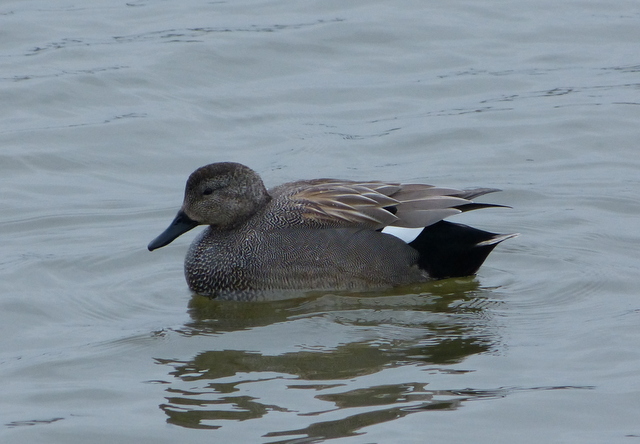 Gadwall – very finely marked when viewed up close.
Gadwall – very finely marked when viewed up close.
Gadwall are a personal favourite. Often overlooked as boring grey (or brown) ducks, we got a close male in the scope and were able to admire the intricate patterning of its feathers. There were about a dozen Pintail as well, a more classically beautiful duck and equally admired.
 Shoveler – sporting its monster of a bill
Shoveler – sporting its monster of a bill
There were also lots of Teal. A little group in front of the hide were squabbling, the males chasing each other, and then they started to display – bending their heads down, folding themselves up out of the water and then flicking their heads forward. Cool moves! Plenty of Shoveler, several Wigeon and the ubiquitous Mallard rounded out the dabblers.
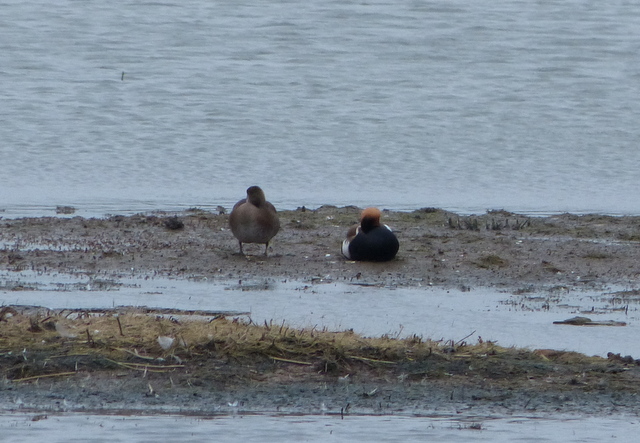 Red-crested Pochard – this pair remained asleep throughout
Red-crested Pochard – this pair remained asleep throughout
We saw a good selection of diving ducks as well. The Red-crested Pochard have reappeared in recent days, and there were several out on the freshmarsh again. Safer not to ask too many questions about where they have some from. With the water levels still high, there were also still plenty of Common Pochard and Tufted Duck. The Goldeneye were harder to get onto, a drake and two ducks, as they were diving all the time, but we got there in the end and watched them as they popped up for a couple of seconds at a time.
 Pochard – still lots on the freshmarsh today
Pochard – still lots on the freshmarsh today
When we started looking, there was a nice variety of waders on the freshmarsh, enjoying the slowly re-emerging islands, now the water levels are going down again. We had time to admire a single Ruff, feeding in amongst the bathing Brent Geese. However, we were just in the process of having a good look at a Bar-tailed Godwit, conveniently in the same view as three Black-tailed Godwits, when they all scattered. We scanned for a raptor overhead, but this time there was nothing and the ducks looked unimpressed. One wader was left – a Snipe was trying to hide along the reedy shore, but couldn’t evade the scope. Very smart.
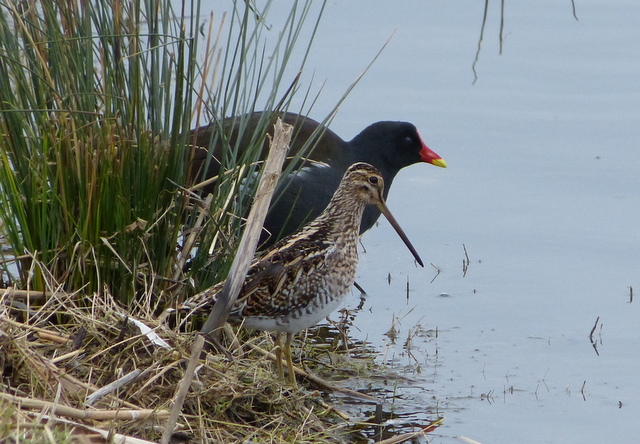 Snipe – and Moorhen, trying to hide on the edge of the freshmarsh
Snipe – and Moorhen, trying to hide on the edge of the freshmarsh
There were a few waders left on the Volunteer Marsh. Lots of Redshank, several Curlew and a nice pair of Grey Plover. A Greenshank flew over calling, but dropped down out on the saltmarsh towards Thornham. Back on the main footpath, we stopped to admire a couple of Black-tailed Godwits feeding in the deep channel alongside.
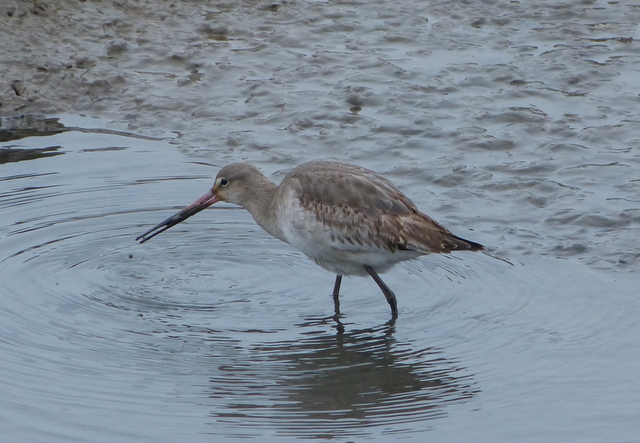 Black-tailed Godwit – feeding on Volunteer Marsh by the path again
Black-tailed Godwit – feeding on Volunteer Marsh by the path again
A couple of Avocets dropped in as well. It was interesting to contrast feeding styles – the Godwits probing with their long, straight bills and the Avocets sweeping their upturned bills from side-to-side through the water.
We braved the beach to add to our list of waders – it was rather cold out there today in the northerly wind. A silvery-grey clockwork Sanderling was running around on the shoreline. A darker and more sedate Turnstone or two were nearby. A couple of dumpy Knots fed amongst the rocks and a Ringed Plover did a very good job of blending in with the background beside them. The sea was a bit choppy, but we just had a chance to have a quick look at a little group of Red-breasted Mergansers, before we decided to head back for a hot drink and a chance to warm up.
Moving on, we headed inland. Up at Choseley, we pulled up by the barns. A couple of Yellowhammers flew in and landed on the hedge behind us. When we turned back round, there were even more on the ground. A couple of Stock Doves strutted around the concrete pad in front of the barns. We were just leaving when a shape flashed across the footpath and down over the field – a Peregrine. It didn’t stop, turning across the road and away.
A little further along, we stopped again. There were even more Brown Hares than usual today – 15 in the field alongside us, another 10 in the next one over and at least 20 across the road. Most of them were lying low in the fields again, but a couple of the nearer ones started to chase each other round in circles. Eventually one turned and they started – more wrestling than boxing, certainly not Queensbury rules, the Choseley Hares are obviously taught to fight dirty! There were definitely fists flying. It was great to watch.
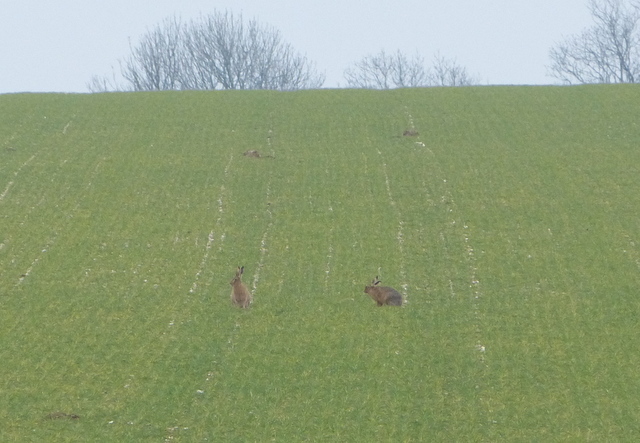 Brown Hares – these two were wrestling today
Brown Hares – these two were wrestling today
Further still and a quick stop to scan a mown set-aside field bore dividends. First a flock of Fieldfare appeared in the grass in front of us. They are obviously still working up the courage to head back to Scandinavia – not surprising, given the cold weather here at the moment! While we were watching them, we found a pair of Mistle Thrush with them, presumably also migrants. A greyish Song Thrush in the base of the hedge was probably heading the same way, too. A good flock of Linnets was in the same field. They were very hard to see on the ground, but periodically they would fly round. Then a small grey and black bird hopped into view. Instantly recognisable – it was a stunning male Wheatear. A classic early spring migrant, this one had presumably chosen to stop off with the crowd just inland. Even better, it was the first we have seen this year.
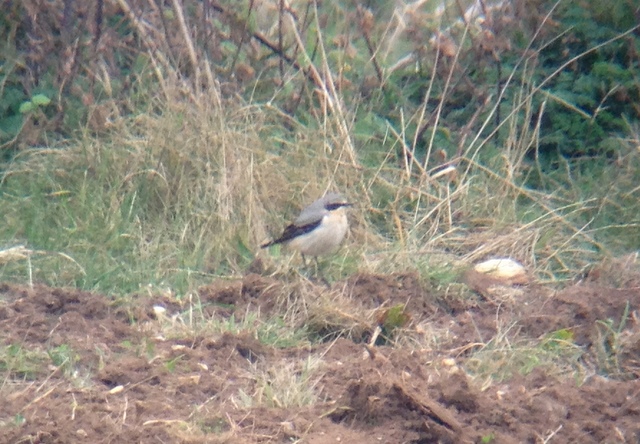 Wheatear – it was a nice surprise to find this male in a field inland today
Wheatear – it was a nice surprise to find this male in a field inland today
From there, we headed round to Holkham. A quick stop by the road on the way produced a Barn Owl out hunting. It must have been a difficult night last night to be out so early. It circled round and round the same overgrown field repeatedly, occasionally stopping to hover or dropping down into the grass. A little group of Pink-footed Geese were feeding distantly in the fields – most of these geese left last month, but a handful are still lingering.
At Lady Anne’s Drive, we paused to look at a big flock of Wigeon out on the grass. A Ruff was in amongst them and several more Fieldfare were in the same field. Suddenly, they all flushed – once again, we couldn’t find any sign of the cause. Walking west along the inland side of the pines, there were lots of Goldcrests and tits calling and the odd Treecreeper. After a question about owl pellets, a quick diversion and we found some. We pulled one apart, all fur and lurking within, a few vole bones.
We climbed up to Joe Jordan hide. The first thing we saw, amongst the Greylags, was a little group of White-fronted Geese. These have spent the winter here but, unlike most of the Pink-footed Geese, have not set off on their way back yet. They should soon be on their way back to Russia.
 White-fronted Goose – check out the white face and black belly bars
White-fronted Goose – check out the white face and black belly bars
We had really wanted to find a Spoonbill, but there was no sign of any activity around the nesting colony today, or the pool nearby where birds were collecting nest material the other day. Perhaps it was the cold again. Somebody in the hide told us they had seen one feeding out in Burnham Overy Harbour earlier, so a long walk through the dunes seemed like it might be in prospect. Then, scanning the marshes, a white shape appeared on the edge of one of the pools. The distinctive feeding action, sweeping its bill from side-to-side deep in the water, gave it away instantly. Spoonbill. We got it in the scope and got a good look at it. Mission accomplished.
 Spoonbill – feeding out on one of the pools this afternoon
Spoonbill – feeding out on one of the pools this afternoon
The Rough-legged Buzzard kept us waiting similarly. We walked on west into the dunes, but there was no sign of it on its favourite posts. We couldn’t see it flying over the dunes either, or lurking down in the grass. Very unusual for it not to be around at this time of the day – where could it be? Scanning back and forth, a bush down in the dunes appeared to have grown, the combination of pale head and dark belly gave it away instantly. A quick look through the scope confirmed that was where the Rough-legged Buzzard was hiding.
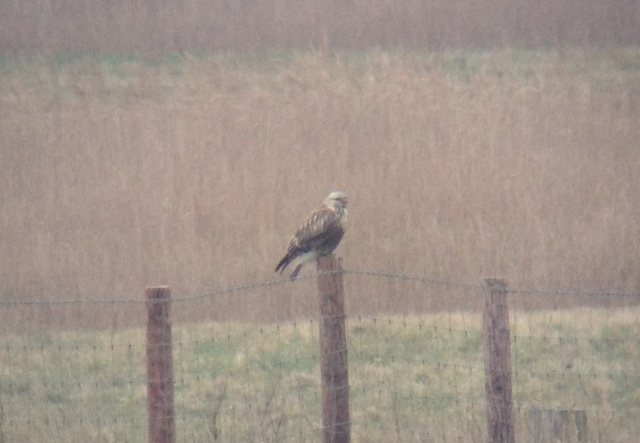 Rough-legged Buzzard – back on one of its favourite posts
Rough-legged Buzzard – back on one of its favourite posts
It sat there for a while, giving us a chance to get a good look at it, before it took off. It flew out across the grazing marsh, turning a couple of times and flashing its black-tipped white tail. The Rough-legged Buzzard then landed back on one of its favourite posts. Situation back to normal. After admiring it for a while, we set off back for home.
